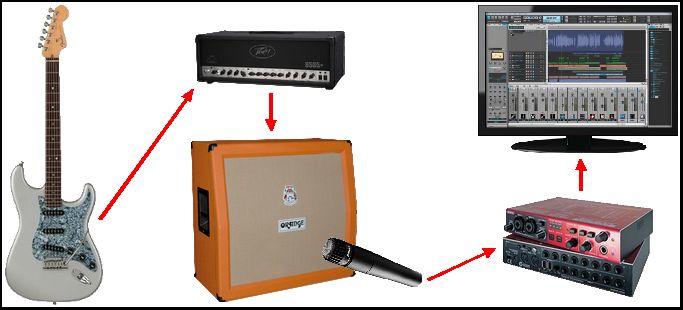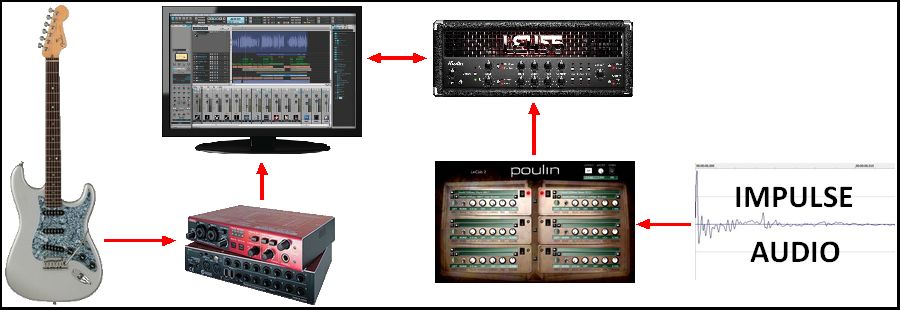

? | Home page | Simulators



This is an essential step. As we are doing Rock music, we are necessarily going to use guitars. And it'd better sound good and heavy and impressive. If guitare comes second, it's not Rock anymore, so you must take very good care of it. But in a home studio, it is not easy to have access to good hardware that will take our guitar sounds to the next level. Real guitar amps are expensive, take space and are very noisy but fortunately, virtual amps have made enormous progress and anyone can now get gear simulations of all kinds.
Amp simulators attempt to reproduce the sound of real guitar and bass amps. Some will recreate one precise model, some will offer access to different models and brands. You can easily find reproductions of the most famous brands from one simulator to the next, but their quality and fidelity to the original can vary much from one sim to the other. You can find both free and retail simulators.
Amp sims of course are only necessary if you don't use a real guitar amp. A good amp sim will allow you to play and record with very limited noise and give excellent results. Frankly, it becomes very difficult to distinguish between a good amp sim and a real amp. Simulators have a bit less dynamics, grain and warmth, but within a good mix, the difference is subtle and if you set the right parameters, most people won't hear any difference. Another advantage in favor of simulators: it doesn't take any physical space and you can have many different models at your disposal without spending a fortune. On the other hand, when it comes to live play, nothing is worth a good old guitar amplifier... But here, we're talking about recording in a home studio.
Caution: I put forward amplifier head simulators, to which you need to add speaker cabinet simulators to build up a complete guitar amplifier. As you can hear, it sounds rather aggressive without a cabinet. According to the cabinet, the microphone and its positionning, you can get very different sounds. It's up to you to find the desired setting. Don't hesitate to use several cabs and several mikes for a single guitar as it allows for a fuller sound.
NB: all the plugins presented here are for PC with Windows. If a Mac version exists, I'll mention it and give you the download link from the official website.






As each D.A.W. is different, I cannot give you the exact procedure but only a general method. Caution: as a Windows PC user, the files I present are for Windows, and so are the explanations below.
1 - Download the plugin file you are interested in.
2 - Unzip the plugin and copy the files it contains in the VST folder of your D.A.W.. I advise you to create a folder for each plugin.
For instance, if you download the TSE X50 zip file, copy its content within the folder "C:\...\VST\TSE - X50".
In order to sort things better, I usually create this type of sub-folders "C:\...\VST\Amp simulators\TSE Plugins\X50", so everything is sorted by type of plugins and by brand.
3 - If your D.A.W. doesn't automatically do it when starting, use its plugin search/analyse function. You may have to close and restart your D.A.W. to recognize the newly installed plugins. Check in the D.A.W.'s options that it knows where to look for. It is usually possible to set one or several paths that will target the folder(s) containing your plugins.
4 - Once the new plugin is recognized by your D.A.W., place it on the track or the bus you want. Some plugins only work if they are placed on stereo tracks or buses.
5 - Place an amplifier simulator first.
6 - Then, place a cabinet simulator, also known as an impulse loader, like LeCab 2 from Poulin, or NadIR, for example.
7 - In the cab simulator, load the impulse of your choice. Impulses, whether they are free or commercial ones, are small-sized wav audio files that you will place wherever you want on your hard drive. They don't need to be located in your VST folder. So load the impulse of your choice, for example a Marshall cabinet impulse.
8 - If everything goes well, you now have an amplifier simulator and a cabinet simulator, very much like a real amplifier.
9 - Click on the "monitoring" button of your guitar track, the very one that allows you to hear yourself playing. You can now enjoy the sound of your virtual guitar/bass amplifier.
10 - Change the settings in the amp simulator windows, set the volume, the bass, mid and trebble, etc. Change the settings as well in the cab simulator if needed (high and low pass, panning...)
11 - Pay attention to the latency. Set it low enough so that there is no delay between the moment you play your guitar and the moment you hear the sound coming out of your headset or monitors. Latency only needs to be very low when you play or record (in order to avoid a sound delay). Once the recording is over, when it is time for mixing, you can raise the latency again, in order to get more processing power. The lower the latency, the more the computer processor will be in use. That can be problematic with big musical projects, if your computer is not powerful enough to process things in real time.

Messages page # 1 2 3 4 5 6 7 8 9 10 11 12 13 14 15 16 17 18 19 20 21 22 23 24 25 26 27 28 29 30 31 32 33 34 35

FromMe
le 13/10/2025 à 12h14
Hello.
So how can I contact LePou?
The latest X64 version of Legion has a bug where the Drive amount jumps when changing from green/red channels. The knob doesn't jump, but you can hear the drive amount jump when tweaking a little bit, so who knows what the default or chosen sound is being used whenever?
Also similar problems with the Engl as well. The old V 1.01 x86 32 bit version of Legion works perfectly however. (but the newer 64 bit version does sound a bit better, sadly).
Has you or anyone else noticed this?
I want to contact him for a way to fix these plugin bugs.
* * * * * * * * * * * * * * * *
Hello,
To my knowledge, Lepou has not been active for years in the simulation community. I think he has completely given up by lack of time and motivation. So I doubt he'll be willing to fix any bugs, and I have no idea how to contact him.
Grebz

musicien-bidouilleur
le 07/09/2025 à 17h58
Juste pour t'encourager et te féliciter pour ton travail. Bonne source d'informations.
J'ai écouté en partie ta musique : il y a un monde entre 2008 et 2020, non pas concernant les titres que j'aime bien mais concernant leur réalisation. 2020 >>> 2008 à mon humble avis.
Le travail et la persévérance paient !
Bravo.
* * * * * * * * * * * * * * * *
Merci beaucoup, ça me fait très plaisir !
Grebz

ace0fspades
le 25/08/2025 à 05h50
Thanks for the free impulses! Great stuff!
* * * * * * * * * * * * * * * *
Thanks for visiting!
Grebz

Jimmy
le 09/12/2021 à 15h16
Hello,
I would like to config my Schuffham S-Gear 2 but I don't know how to do.
I have Logic Pro X.6.2 with S-Gear plugin
I found your website and I ask myself what does it means in the folder Schuffham S-Gear 2.
I don't understand what you have writing like in this exemple : Guitar on the left:
1 impulse of baffle Marshall 1960A (loudspeaker: G12M) through a microphone Neumann U67 in Cap Edge position, at a distance of 2 inches (5 cm). Stereo panning: 100% left.
1 impulse of baffle Marshall 1960A (loudspeaker: G12M) through a microphone Neumann U87 in Cap Edge position, at a distance of 4 inches (10 cm). Stereo panning: 100% left.
How can I find the same sound as you ? How can I do to config my own S-Gear with these parameters ? What does it means ?
Sorry for my English ;) I’m French !
You can answer me directly on my email address.
Thanks in advance.
Jimmy

Labrava
le 29/10/2021 à 13h49
Hi Grebz,
I don't know if you read these... but I was wondering if your Lepou plugins are x32 or x64? Thanks for all the great stuff on here!
* * * * * * * * * * * * * * * *
Hello, thanks for visiting my website. They're x64.
Grebz
